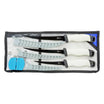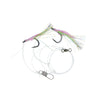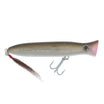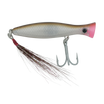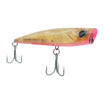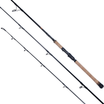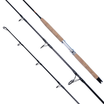Weight and Balance:
Hook size can affect the weight and balance of a lure, potentially altering its action. Larger hooks might weigh down a lure, changing its swimming pattern, while smaller hooks might allow for a more natural presentation.
Optimal swimming the action of the lure.
- Balance Impact: Heavier hooks can affect the buoyancy and balance of the lure, causing it to sink or swim differently. Use hooks with appropriate weight to maintain the intended swimming depth and action of the lure. Ensure the hook is balanced and positioned correctly to maintain the lure's natural movement and prevent it from rolling or tilting. A savvy angler understands a lure’s weight relative to its position on the lure to ensure best balance. Most plugs have a very intentional balancing system inside the lure. Hook weight demands and placement work in conjunction with the lures overall shape and internal weighting system. At Hogy we obsess over this. Since day one, we weight and balance all our plugs to swim properly with just the front hook. We accomplish this by lowering the center of gravity of the weight we put into plugs, often segmenting weights in chambers to ensure the weight stays where it’s designing too. An improperly balanced lure will change its orientation in the water which could deter the lure from achieving its optimal hydrodynamics. A popper is a good example here. We release a “Long Range” casting popper this year with casting distance taking priority over floatation. That means we added lots of weight to the lure to cast. But how a popper sinks is critically important. Imagine a popper sinking back down? It would take a lot of work to get it to swim after stalling. Rather, our Long-Range Casting Popper is designed for a “uniform descent” to the lure hit’s instant swimming action once its retrieved. A too heavy hook in the back could impact this dynamic.
- Buoyancy Impact: Heavier hooks can affect the buoyancy and balance of the lure, causing it to sink or swim differently. The best plugs have buoyancy highly factored in. At the most basic level, plugs can be designed to float or sink. But other considerations are factored in like sink rate, an sink orientation. A slider for example is designed to sink uniformly, meaning that the tail hook eye is in line with the front oull eye as it sinks. Not only does this ensure a natural “stunned action” it also ensures that the lure will swim perfectly the second it’s retrieved again. In this case, altering the balance will impact the lures action.
- Drag Impact: Larger hooks can create more drag, potentially slowing the lure's action and altering its swimming motion. Ensure the hook size matches the lure size to maintain optimal action without overwhelming the lure. A treble hook often has more drag but less weight than a modern inline single. Bucktails on the back of a lure add a lot of drag and can factor into the lures action and the front hook size and shape.
- Flags: A plug flag, typically a hand-tied piece of material attached to the rear of a lure, enhances its visual appeal and action. It mimics the movement of a distressed baitfish, attracting more strikes. Additionally, a plug flag can help maintain lure balance and reduce the need for additional hooks, thereby minimizing fish injury during catch and release.
Balance:
The length of the pole holding the bucktail can add subtle weight to the lure, affecting its balance and action. Typically made of stainless steel, this pole adds extra weight, which can help stabilize the lure and ensure it runs true, especially in rough water conditions.
Drag and action:
The length of the bucktail can slow down the wobble of the lure, resulting in a more nuanced presentation. The length of the hair used in the plug flag is critical. Longer hair can create a more pronounced “serpentine” action, mimicking the movement of a distressed baitfish. This increased motion can attract more strikes by making the lure appear more lifelike and enticing.
Color Impact:
Color choice is an opportunity to dial in your lure to specific situations
- Black on Black:Using black hair on a black plug can make the lure look like an eel, a common prey for many game fish. This combination is particularly effective in low-light conditions or murky water.
- Darker Color on Lighter Plug:Attaching a darker-colored flag to a lighter-colored plug can simulate a fish's tail. Many fish species have darker tails, making this color scheme more natural and appealing to predators.
Size Perception:
Flags can make the plug look much bigger without adding significant weight. This visual enhancement makes the lure appear more substantial and can be particularly effective in attracting larger fish that are seeking a more sizable meal.
Conclusion:
By carefully selecting the length, color, and hair type of the plug flag, anglers can significantly enhance the lure's performance. The added weight from the stainless pole contributes to the lure's stability and effectiveness, making it more attractive to fish and increasing the chances of a successful catch.




















